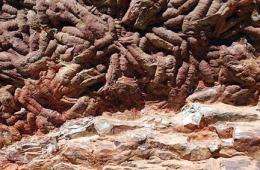Giant marine worms lived 475 million years ago: scientists

Spanish researchers said Monday they have discovered evidence of a type of giant worm that lived 475 million years ago and was up to one metre (three feet) in length.
The fossilised tracks of the marine worms were found in the Cabaneros National Park in central Spain in an area that was a seabed during the Lower Ordovician period, the Spanish National Research Council (CSIC) said.
It said the creatures lived in horizontal galleries of five metres in length and 15-20 centimetres in diameter under the seabed.
The galleries were lined "with mucous secretions to harden them and prevent their collapse, which has facilitated their preservation," said paleontologist Juan Carlos Gutierrez Marco.
They are the "oldest tracks of giant worms" ever discovered, pre-dating those found in Devon, England, this year and which dated from 200 million years ago, the CSIC quoted him as saying.
He explained why the worms, which were up to one metre in length and 15 centimetres in diameter, could attain such great size.
"For more than 450 millions years ago our country was part of a marine platform of an ancient continent called Gondwana," Gutierrez Marco said.
"The Iberian Peninsula was then near the south pole of the era. Organisms living in very cold water have a metabolism that allows them to grow bigger -- what is known as polar gigantism."
(c) 2009 AFP
















